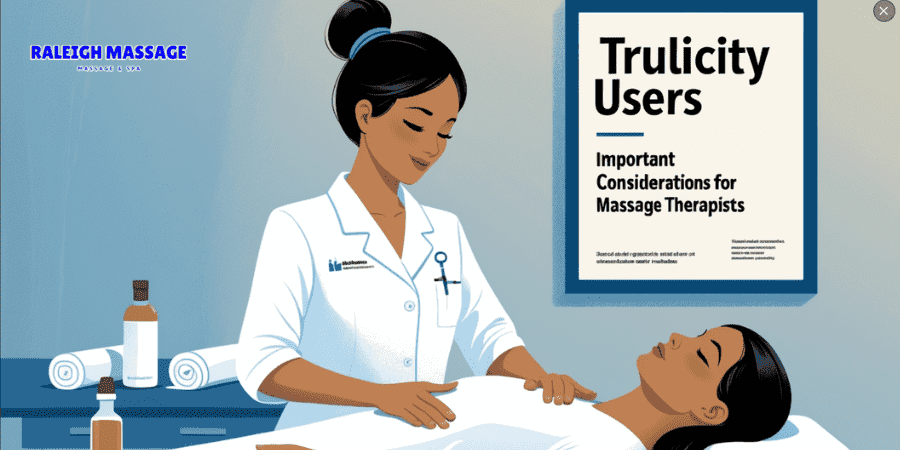Trulicity and Its Effects on the Body
If you’re a massage therapist, you treat clients with a range of health issues. Some of them take medications that affect their bodies in ways you should be informed of. One of these medications is called Trulicity users. If you’ve never encountered it, it’s a prescription drug that is utilized to help patients with type 2 diabetes control their blood sugars.
But why should you, a massage therapist, care? Because Trulicity affects circulation, blood glucose, and digestion, all of which are of concern to you when you’re working on a massage client. Learning how this medicine works and how it affects the body will allow you to give your clients the most effective and safest treatment.
What Is Trulicity?
Trulicity (Dulaglutide) is a prescription medicine that is administered via injection to control blood sugar in patients having type 2 diabetes. It induces insulin release and slows down digestion, keeping blood glucose in control. Weight loss is also a side effect in most patients, a welcome added benefit to many.
However, this medication has side effects that massage practitioners should be careful of. Among the most common of such side effects are dizziness, nausea, low blood sugar (hypoglycemia), and even dehydration. These are something you should be aware of in advance and during a massage treatment.
How Trulicity Affects Massage Therapy Sessions
1. Blood Sugar and Hypoglycemia Risk
One of the most important facts to know is that Trulicity lowers blood sugar. If you have not eaten before, you can become dizzy or even faint.
Before starting, check to see if they’ve eaten recently. If they become lightheaded, give a drink of water or a small snack. Keep juice or candy on hand in case their blood sugar drops unexpectedly.
Low blood sugar also causes sweating, shakiness, confusion, and even loss of consciousness in serious situations. As a therapist, it is helpful to be aware of these symptoms to take action immediately if need be. Proper communication with a clear plan in place beforehand can prevent crises.
2. Circulation and Bruising Concerns
Trulicity may affect circulation. Some patients on this drug can be more likely to bruise, especially when injecting it in their thighs, arms, or belly. Deep tissue or heavy pressure injections can be painful or even cause bruising.
Ask your client where they inject their medication. Avoid working directly over injection sites. Instead, use gentle techniques around those areas to prevent irritation.
Bruising can be delayed in coming on, sometimes up to a few days, so a client may not even be aware of it immediately. Watch for pressure and maintain open communication during the session.
3. Digestive Issues and Nausea
Trulicity slows down digestion, resulting in nausea, bloating, or stomach discomfort. Prolonged face-down position can aggravate these side effects.
If your client is nauseated, reposition them. Side-lying or semi-reclined position is often more tolerable. Strong scents of aromatherapy should also be avoided, as they can be a stimulus to nausea in some cases.
Encourage your clients to inform you if they start to feel uncomfortable. Some won’t be willing to tell you that they feel unwell, so check-ins during regular intervals are important.
4. Dehydration and Muscle Cramps
Some Trulicity patients suffer from dehydration. This can manifest in muscle cramps, tension, and headaches. Because massage enhances circulation, it is crucial that your client is well-hydrated.
Encourage them to drink plenty of water beforehand and after their session. This will also help to minimize muscle soreness and maintain their feeling of well-being.
Proper hydration also avoids dizziness, a side effect of use of Trulicity. Giving a drink of water at the end of the session is a quick and helpful way to help.
Best Massage Techniques for Trulicity Users
Not all massage methods apply to every client. With a person on Trulicity, a cautious and careful approach is advisable. The following methods apply:
- Swedish Massage: Gentle, flowing strokes help with relaxation and circulation without being too intense.
- Lymphatic Drainage Massage: Eases fluid accumulation and circulation, beneficial to users of Trulicity.
- Reflexology: Works on feet and hands, except for areas that get injections.
- Aromatherapy Massage: In instances of no nausea, there also exist oils that relax and give relief from stress.
Avoid deep tissue or intense pressure methods except in cases where the client is okay with it. Always check in with them throughout the session.
If your client prefers deep pressure but is concerned about bruising, use more gradual, slower approaches in place of sudden or forceful pressure.
Pre-Massage Questions for Trulicity Users
To ensure a safe massage that is also effective, you should question your client a few questions beforehand:
- Have you eaten recently? (to avert low blood sugar attacks)
- Where do you inject Trulicity (to not put direct pressure on those areas)?
- Are you queasy or lightheaded today? (to adjust the session accordingly)
- Are you hydrating in a way that prevents dehydration complications?
- Do you feel any new bruising or sensitivity (to adjust pressure accordingly)?
These questions will allow you to tailor the session to their needs and continue to maintain their comfort.
As a massage therapist, you would like to allow clients to feel their best. An understanding of how Trulicity affects the body allows you to deliver a more productive, more secure massage. Take blood glucose levels, circulatory patterns, nausea, and hydration needs into account.
By asking questions in a relevant manner and making adjustments to your approach, you can provide a great experience to users of Trulicity without compromising their health.
For more expert massage services, visit Raleigh Massage.
By being aware of these facts, you can deliver a pleasant, relaxing, and beneficial massage treatment to your patients using Trulicity.
FAQs
1. Can a person on Trulicity receive a deep tissue massage?
Deep tissue massage is likely to be associated with bruising in patients on Trulicity. Begin gently and check in with your client to assess their comfort.
2. Should Trulicity users eat before a massage?
Yes. Since Trulicity is a medicine that reduces blood sugar, a light meal in advance can help to prevent dizziness or fainting.
3. What should I do if someone on Trulicity is getting queasy during a massage?
Adjust their side or reclined position. Offer water and avoid exposure to odors that lead to nausea.
4. Can you get a massage after you get your shot of Trulicity?
>Yes, but do not massage over the injection point to avoid irritation. Inquire of your client where he or she is injecting the medication.
5. How do I help a Trulicity user stay hydrated after a massage?
Encourage them to drink large amounts of water in advance of and after the session to prevent muscle cramps and dehydration complications.








